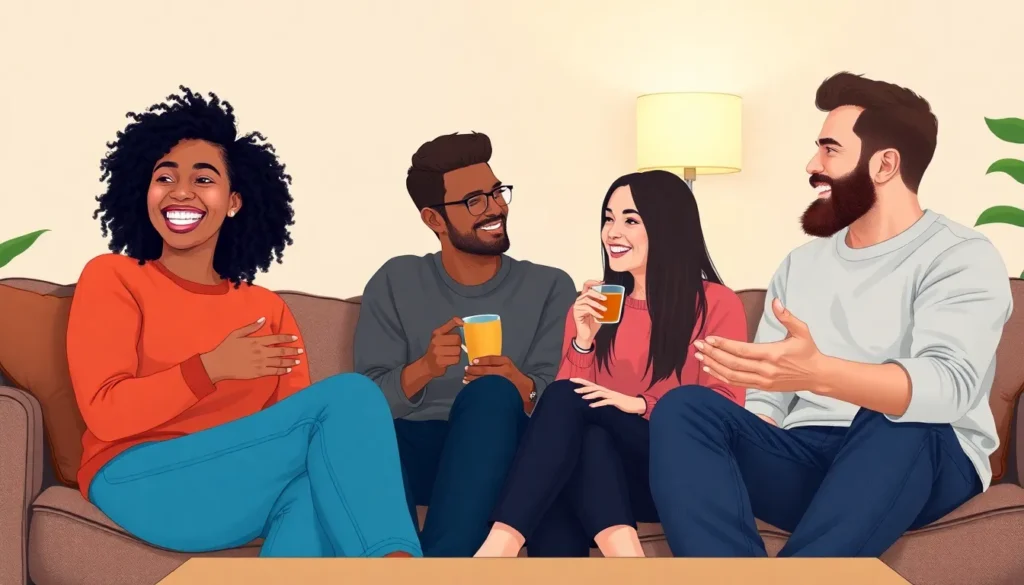Friendships should be a two-way street, not a one-way highway to nowhere. If you’ve ever felt like you’re the only one putting in the effort, it’s time to hit the brakes and reassess. One-sided friendships can drain your energy faster than a smartphone on 1% battery.
Table of Contents
ToggleUnderstanding One Sided Friendships
One-sided friendships lack balance and mutual investment. In such relationships, one person consistently gives more than they receive, leading to emotional exhaustion.
Defining One Sided Friendships
One-sided friendships occur when one party invests significantly more effort than the other. These relationships may appear asymmetrical due to unequal emotional support or communication levels. For example, one friend may initiate most conversations or provide help regularly, while the other remains unresponsive. This imbalance fosters feelings of resentment and disillusionment over time.
Signs of a One Sided Friendship
Several signs indicate a one-sided friendship. Frequent initiation from one side shows an uneven effort in maintaining the relationship. Conversations may feel forced when one friend dominates discussions without reciprocation. Additionally, lack of support during difficult times signals an imbalance. Friends unwilling to prioritize each other’s needs reflect diminished care and concern. Recognizing these signs helps individuals assess the relationships and determine their value.
The Emotional Impact of One Sided Friendships
One-sided friendships lead to significant emotional strain. Individuals often feel unappreciated despite their efforts.
Feeling Unappreciated
Feeling unappreciated becomes common in one-sided friendships. Constantly reaching out without reciprocation fosters a sense of neglect. Friends who don’t acknowledge contributions can diminish self-worth. Recognizing one’s importance in a relationship is crucial, and the absence of recognition causes emotional pain. Those involved might invest time and energy, yet receive little acknowledgment in return. Disappointment grows as efforts go unnoticed. Eventually, this lack of appreciation can manifest in frustration and resentment.
The Toll on Mental Health
The toll on mental health in one-sided friendships is profound. Emotional exhaustion can lead to anxiety and low self-esteem. Persistently feeling undervalued creates a toxic environment that hampers personal growth. Individuals may experience increased feelings of loneliness despite the presence of a friend. They might withdraw from social situations, fearing further disappointment. Over time, unresolved feelings build, leading to depression or burnout. Recognizing these adverse effects can prompt individuals to reassess their relationships and prioritize healthier connections.
Recognizing When to Move On
Identifying when to move on from a friendship can bring clarity and peace of mind. Recognizing these signs can significantly enhance emotional well-being.
Red Flags to Watch For
Signs indicate a one-sided friendship requires evaluation. Frequent initiation from one party often points to imbalance. Conversational struggles highlight disinterest or lack of engagement. Instances of minimal support during tough times establish a pattern of neglect. Consistently feeling unappreciated underscores the emotional toll. Furthermore, one-sided efforts lead to resentment, showing an unhealthy dynamic. Individuals should take note of these red flags to reassess their relationships effectively.
Evaluating the Friendship
Assessing a friendship involves reflecting on personal feelings and experiences. One question to consider is whether interactions leave one feeling valued or drained. While evaluating, take note of conflicts or misunderstandings that remain unresolved. Consider the frequency of positive experiences compared to negative ones. Individuals should ask themselves if the relationship encourages personal growth. If thoughts of disengagement arise, it may signal the need for a serious conversation or a decision to move on. Engaging in honest self-reflection promotes healthier connections.
Strategies for Ending One Sided Friendships
Ending one-sided friendships can promote emotional well-being and foster healthier connections. Several strategies facilitate this transition effectively.
Approaching the Conversation
Starting the conversation requires clarity and honesty. Focus on personal feelings rather than blaming the other person. Use “I” statements to express how the friendship impacts emotional health. Encouraging open dialogue creates a safe space for discussion. Acknowledging their perspective can help maintain respect, even in disagreement. Timing plays a crucial role; choosing a calm moment improves the chances of a constructive outcome. Prepare for various responses; some may be surprised while others might acknowledge the imbalance. Establishing an understanding allows for mutual closure.
Setting Boundaries
Establishing boundaries clarifies expectations in friendships. Identifying personal needs serves as the foundation for setting these limits. Communicate specific behaviors that lead to discomfort, making requests clear and direct. Annual check-ins can help reinforce boundaries and ensure they’re respected. Consistency remains vital; uphold boundaries regardless of circumstances. Observing reactions to boundaries can provide insights into the friendship’s value. Prioritizing personal well-being fosters healthier connections, leading to more balanced relationships. Redefining interactions after establishing boundaries enables deeper, more meaningful connections with others.
Embracing Healthy Friendships
Healthy friendships thrive on mutual effort and respect. Individuals in these relationships actively support each other, creating an environment of trust and understanding.
What Healthy Friendships Look Like
Healthy friendships exhibit characteristics of balance and reciprocity. Friends share both joys and burdens, ensuring each party feels valued. Open communication remains crucial, allowing discussions about feelings and expectations. Respectful behaviors, such as listening and offering assistance, enhance connection. Individuals in healthy friendships spend quality time together, enjoying shared activities that strengthen their bond. Support during challenging times highlights commitment. Both friends celebrate each other’s achievements, fostering a sense of belonging and appreciation.
Nurturing Mutual Relationships
Nurturing mutual relationships requires intentional actions and investments. Regular check-ins maintain connection and demonstrate care. Sharing experiences helps create lasting memories and deepens understanding. Establishing clear boundaries encourages healthy interactions and prevents resentment. Expressing gratitude reinforces positive feelings and acknowledges efforts made by both friends. Cultivating kindness and empathy strengthens ties and enhances emotional investment. Empowering one another to grow leads to a fulfilling friendship that stands the test of time. Individuals should prioritize these practices to build solid, supportive relationships.
Recognizing the signs of one-sided friendships is crucial for emotional health. It’s essential to prioritize relationships that offer mutual support and respect. Letting go of connections that drain energy and self-worth can lead to more fulfilling interactions.
By setting clear boundaries and engaging in open communication, individuals can foster healthier friendships. It’s not just about ending unbalanced relationships; it’s about making room for those that enrich life and promote growth.
Investing in reciprocal friendships can lead to greater happiness and fulfillment. Ultimately, surrounding oneself with supportive and caring individuals creates a positive environment that nurtures well-being and personal development.







